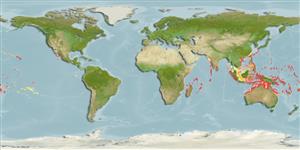Common names from other countries
Environment: milieu / climate zone / depth range / distribution range
Ecologie
marien rifbewoner; diepte 0 - 50 m (Ref. 90102). Tropical; 30°N - 25°S
Indo-Pacific: Maldives to the Tuamoto Islands, north to Ryukyu Islands, south to the Great Barrier Reef.
Grootte / Gewicht / Leeftijd
Maturity: Lm ? range ? - ? cm
Max length : 26.0 cm TL mannelijk / geslacht onbekend; (Ref. 9710)
Dorsale stekels (totaal) : 13 - 14; Dorsale zachte stralen (totaal) : 23 - 26; Anale stekels: 3; Anale zachte stralen: 19 - 22. The abdominal region of females is noticeably thick set. Body is golden yellow; base of the posterior portions of the dorsal and anal fins black; a prominent vertical black bar running across the eye; diagonal rows of black dots on the sides. A filament originating from the soft portions of the dorsal fin rays trails posteriorly (Ref. 4855). Snout length 2.4-2.9 in HL. Body depth 1.6-1.9 in SL (Ref. 90102).
Uncommon species (Ref. 9710) found in coral rich areas of clear water lagoon and semi-protected seaward reefs. Usually in pairs or small groups, more wary than most species. Minimum depth reported taken from Ref. 30874. Oviparous (Ref. 205). Minimum depth reported taken from Ref. 128797.
Levenscyclus en paargedrag
Maturities | Voortplanting | Spawnings | Egg(s) | Fecundities | Larven
Distinct pairing (Ref. 205).
Myers, R.F., 1991. Micronesian reef fishes. Second Ed. Coral Graphics, Barrigada, Guam. 298 p. (Ref. 1602)
Status op de Rode Lijst van het IUCN (Ref. 130435)
CITES (Ref. 128078)
Not Evaluated
Gevaar voor de mens
Harmless
Gebruik door de mens
Visserij: van minder commercieel belang; Aquarium: Commercieel
Tools
Speciale rapporten
Download XML
Internetbronnen
Estimates based on models
Preferred temperature (Ref.
115969): 24.9 - 28.9, mean 27.7 (based on 646 cells).
Fylogenetische diversiteitsindex (Ref.
82804): PD
50 = 0.5000 [Uniqueness, from 0.5 = low to 2.0 = high].
Bayesian length-weight: a=0.02291 (0.01133 - 0.04632), b=3.00 (2.83 - 3.17), in cm Total Length, based on LWR estimates for this Genus-body shape (Ref.
93245).
Trofisch niveau (Ref.
69278): 2.7 ±0.25 se; based on food items.
Weerstandsvermogen (Ref.
120179): Hoog, minimale populatieverdubbelingstijd minder dan 15 maanden (Preliminary K or Fecundity.).
Fishing Vulnerability (Ref.
59153): Low vulnerability (16 of 100).
